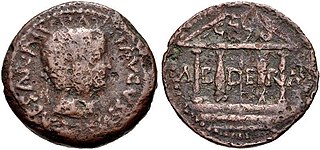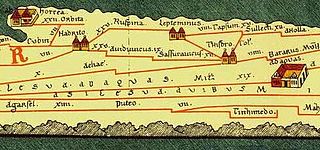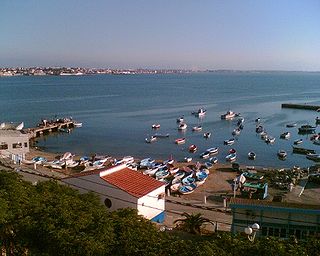Related Research Articles

Abdera was an ancient Carthaginian and Roman port on a hill above the modern Adra on the southeastern Mediterranean coast of Spain. It was located between Malaca and Carthago Nova in the district inhabited by the Bastuli.

Carthage was an ancient city in Northern Africa, on the eastern side of the Lake of Tunis in what is now Tunisia. Carthage was one of the most important trading hubs of the Ancient Mediterranean and one of the most affluent cities of the classical world. It became the capital city of the civilisation of Ancient Carthage and later Roman Carthage.
Hamilcar was a common Carthaginian masculine given name. The name was particularly common among the ruling families of ancient Carthage.
Sulci or Sulki, was one of the most considerable cities of ancient Sardinia, situated in the southwest corner of the island, on a small island, now called Isola di Sant'Antioco, which is, however, joined to the mainland by a narrow isthmus or neck of sand. South of this isthmus, between the island and the mainland, is an extensive bay, now called the Golfo di Palmas, which was known in ancient times as the Sulcitanus Portus (Ptol.).

Skikda is a city in northeastern Algeria and a port on the Mediterranean. It is the capital of Skikda Province and Skikda District.
Mago was a Carthaginian writer, author of an agricultural manual in Punic which was a record of the farming knowledge of Carthage. The Punic text has been lost, but some fragments of Greek and Latin translations survive.

The Punic people, usually known as the Carthaginians, were a Semitic people who migrated from Phoenicia to the Western Mediterranean during the Early Iron Age. In modern scholarship, the term Punic, the Latin equivalent of the Greek-derived term Phoenician, is exclusively used to refer to Phoenicians in the western Mediterranean, following the line of the Greek East and Latin West. The largest Punic settlement was Ancient Carthage, but there were 300 other settlements along the North African coast from Leptis Magna in modern Libya to Mogador in southern Morocco, as well as western Sicily, southern Sardinia, the southern and eastern coasts of the Iberian Peninsula, Malta, and Ibiza. Their language, Punic, was a variety of Phoenician, one of the Northwest Semitic languages originating in the Levant.

Leptis or Lepcis Parva was a Phoenician colony and Carthaginian and Roman port on Africa's Mediterranean coast, corresponding to the modern town Lemta, just south of Monastir, Tunisia. In antiquity, it was one of the wealthiest cities in the region.

The siege of Utica was a siege during the Second Punic War between the Roman Republic and Carthage in 204 BC. Roman general Scipio Africanus besieged Utica, intending to use it as a supply base for his campaign against Carthage in North Africa. He launched repeated and coordinated army-navy assaults on the city, all of which failed. The arrival of a large Carthaginian and Numidian relief army under Carthaginian general Hasdrubal Gisco and Numidian king Syphax in late autumn forced Scipio to break off the siege after 40 days and retreat to the coast.

Neapolis was an ancient city of Sardinia founded by the Carthaginians in the sixth century BC, and apparently one of its most important places. It was situated on the west coast, at the southern end of the Gulf of Oristano, at the present-day località of Santa Maria di Nabui, in the comune of Guspini, Province of South Sardinia.

Eryx was an ancient city and a mountain of Magna Graecia in the west of Sicily, about 10 km from Drepana, and 3 km from the sea-coast. It was located at the site of modern Erice.

The city of Carthage was founded in the 9th century BC on the coast of Northwest Africa, in what is now Tunisia, as one of a number of Phoenician settlements in the western Mediterranean created to facilitate trade from the city of Tyre on the coast of what is now Lebanon. The name of both the city and the wider republic that grew out of it, Carthage developed into a significant trading empire throughout the Mediterranean. The date from which Carthage can be counted as an independent power cannot exactly be determined, and probably nothing distinguished Carthage from the other Phoenician colonies in Northwest Africa and the Mediterranean during 800–700 BC. By the end of the 7th century BC, Carthage was becoming one of the leading commercial centres of the West Mediterranean region. After a long conflict with the emerging Roman Republic, known as the Punic Wars, Rome finally destroyed Carthage in 146 BC. A Roman Carthage was established on the ruins of the first. Roman Carthage was eventually destroyed—its walls torn down, its water supply cut off, and its harbours made unusable—following its conquest by Arab invaders at the close of the 7th century. It was replaced by Tunis as the major regional centre, which has spread to include the ancient site of Carthage in a modern suburb.

Tamentfoust, the classical Rusguniae and colonial La Pérouse, is a site in the Dar El Beïda District of Algiers in Algeria.

Rusadir was an ancient Punic and Roman town at what is now Melilla, Spain, in northwest Africa. Under the Roman Empire, it was a colony in the province of Mauretania Tingitana.

Ancient Carthage was an ancient Semitic civilisation based in North Africa. Initially a settlement in present-day Tunisia, it later became a city-state and then an empire. Founded by the Phoenicians in the ninth century BC, Carthage reached its height in the fourth century BC as one of the largest metropoleis in the world. It was the centre of the Carthaginian Empire, a major power led by the Punic people who dominated the ancient western and central Mediterranean Sea. Following the Punic Wars, Carthage was destroyed by the Romans in 146 BC, who later rebuilt the city lavishly.

Azeffoun, the classical Rusazus and colonial Port Gueydon, is a town and commune in Tizi Ouzou Province in northern Algeria, located on Cape Corbelin 64 km (40 mi) north-east of Tizi Ouzou. The economy of the town of Azeffoun is based on tourism, fishing, and agriculture.

Cartennae or Cartenna was an ancient Carthaginian and Roman port at present-day Ténès, Algeria. Under the Romans, it was part of the province of Mauretania Caesariensis.

Bithia or Bitia was a Phoenician, Carthaginian, and Roman town located near Chia in the extreme south of Sardinia, Italy. Most of the ruins have been submerged underwater.
Rusazus was a Phoenician, Carthaginian, and Roman town located near Cape Corbelin, Algeria. Its ruins are near the town of Azeffoun.

Lapathus, also recorded as Lapethus, Lepethis, and Lapithus, was an ancient Cypriot, Phoenician and Greek town near present-day Lampousa and Karavas.
References
Citations
- ↑ Macbean, A. (1773). A Dictionary of Ancient Geography: Explaining the Local Appellations in Sacred, Grecian, and Roman History. London: G. Robinson. p. 14. OCLC 6478604.
Africa propria (Pliny's Natural History).
- 1 2 3 Huss (2006).
- ↑ Strabo, Geogr., Book XVII, Ch. iii, §12.
- ↑ Strabo, Geography,§17.3.12
- ↑ Ptol., Geogr. , Book IV, Ch. iii, §9.
- ↑ Cass. Dio, Rom. Hist., Book XLII, Ch. lviii, §4.
- ↑ Davis, Nathan (1862-01-01). Ruined Cities Within Numidian and Carthaginian Territories. J. Murray.
- ↑ Jul. Caes., Bell. Afr. , Book VI, §7, and Book IX, §1.
Bibliography
- Huss, Werner (2006), "Ruspina", Brill's New Pauly Encyclopedia of the Ancient World, Leiden: Brill.
35°46′10″N10°49′31″E / 35.7694°N 10.8253°E